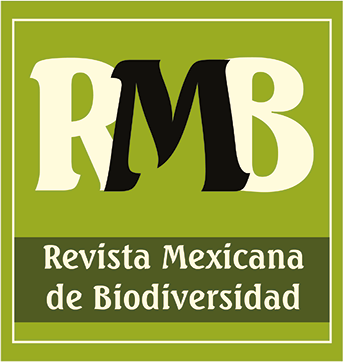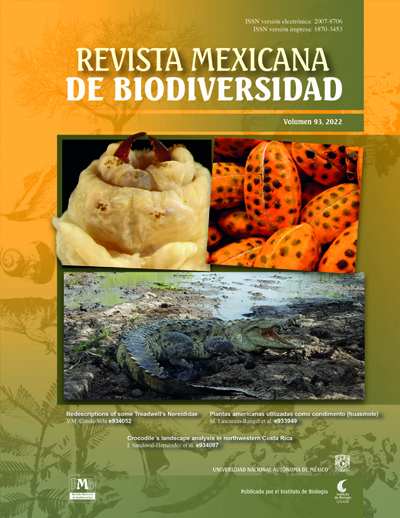Rhinonyssidae and Ereynetidae mites in Columba livia (Columbiformes: Columbidae) in southern Brazil
DOI:
https://doi.org/10.22201/ib.20078706e.2022.93.3983Keywords:
Acari, Tinaminyssus, Trispeleognathus, Parasitological indices, CoinfectionsAbstract
This study aims to record mites associated with the respiratory system of Columba livia Gmelin, 1789, including data of parasitological indices and of coinfections in southern Brazil. Two hundred and two specimens of C. livia were collected in the urban area in Pelotas, Rio Grande do Sul (RS) state, Brazil. Fifty-six (27.7%) birds were parasitized by Rhinonyssidae and Ereynetidae mites. Tinaminyssus columbae (Crossley, 1950) and Tinaminyssus melloi (Castro, 1948) (Rhinonyssidae) were found in nasal cavities and tracheae of the birds. Trispeleognathus striatus (Crossley, 1952) (Ereynetidae) was found in hosts’ nasal cavities. The prevalence of Rhinonyssidae mites
(25.2%) was significantly higher than obtained for Ereynetidae (5.9%). Coinfections only occurred in nasal cavities of 8 (3.96%) birds. This study records for the first time T. columbae and Trispeleognathus striatus parasitizing C. livia in Brazil. In addition, mite infection indices and coinfections of Rhinonyssidae and Ereynetidae mites in this Columbidae species are recorded.
References
Amaral, V. (1963). The occurrence of the nasal mite Trispeleognathus striatus (Crossley, 1952), Fain, 1962 (Ereynetidae Oudemans, 1931) from Leptotila verreauxi (Aves: Columbiformes). Arquivos do Instituto Biológico de São Paulo, 30, 91.
Amaral, V., & Rebouças, M. M. (1974). Notas sobre ácaros rinonissídeos de aves brasileiras (Mesostigmata: Rhinonyssidae). O Biológico, 40, 52–56.
Belton, W. (1994). Aves do Rio Grande do Sul: Distribuição e Biologia. São Leopoldo: Unisinos.
Bernardon, F. F., Mascarenhas, C. S., Pereira, Jr, J., & Müller, G. (2018). Host Parasite relationships and coinfection of nasal mites of Chrysomus ruficapillus (Passeriformes: Icteridae) in southern Brazil. Iheringia, Série Zoologia, 108, 1–7. https://doi.org/10.1590/1678-4766e2018025
Bush, A. O., Lafferty, K. D., Lotz, J. M., & Shostak, A. W. (1997). Parasitology meets ecology on its own terms: Margolis et al., revisited*. Journal of Parasitology, 83, 575–583. https://doi.org/10.2307/3284227
Butenko, O. M., & Stanyukovich, M. K. (1999). The distribution of rhinonyssid mites (Acari, Gamasida, Rhinonyssidae) in the nasal cavities of some anatid birds. Ekologiya, 2, 52–56.
Castro, M. P. (1948). Reestruturação genérica da família Rhinonyssidae Vitzthum 1935 (Acari: Mesostigmata: Gamasides) e descrição de algumas espécies novas. Arquivos do Instituto Biológico, 18, 253–284.
Crossley, D. A. (1950). A new species of nasal mite Neonyssus (Neonyssus) columbae, from the pigeon. Proceedings of the Entomological Society of Washington, 52, 309–313.
Crossley, D. A. (1952). Two new nasal mites from Columbiform birds. Journal of Parasitology, 38, 385–390.
de Rojas, M., Doña, J., & Dimov, I. (2020). A comprehensive survey of Rhinonyssid mites (Mesostigmata: Rhinonyssidae) in Northwest Russia: New mite-host associations and prevalence data. Biodiversity Data Journal, 8, 1–37. https://doi.org/10.3897/BDJ.8.e49535
de Rojas, M., Doña, J., Jovani, R., Dimov, I., Zurita, A., Callejón, R. et al. (2018). Evidence of cryptic species in the genus Tinaminyssus (Acari: Rhinonyssidae) based on morphometrical and molecular data. Experimental and Applied Acarology, 75, 355–368. https://doi.org/10.1007/s10493-018-0271-x
de Rojas, M., Mora, M. D., Úbeda, J. M., Cutillas, C., Navajas, M., & Guevara, D. C. (2001). Phylogenetic relationships in rhinonyssid mites (Acari: Rhinonyssidae) based on mitochondrial 16S rDNA sequences. Experimental and Applied Acarology, 25, 957–967. https://doi.org/10.1023/A:1020651214274
de Rojas, M., Mora, M. D., Úbeda, J. M., Cutillas, C., Navajas, M., & Guevara, D. C. (2002). Phylogenetic relationships in rhinonyssid mites (Acari: Rhinonyssidae) based on ribosomal DNA sequences: insights for the discrimination of closely related species. Parasitology Research, 88, 675–681. https://doi.org/10.1007/s00436-002-0647-y
Dimov, I., & Mascarenhas, C. S. (2012). Co-parasitism of mites in Passeriformes birds from northwest Russia and southern Brazil. Journal of Science and Practice, 1, 7–10.
Domrow, R. (1969). The nasal mites of Queensland birds (Acari: Dermanyssidae, Ereynetidae and Epidermoptidae). Proceedings of the Linnean Society of New South Wales, 93, 297–426.
Fain, A. (1957). Les acariens de la famille Epidermoptidae et Rhinonyssidae parasites dês fosses nasals d´oiseaux au Ruanda-Urundi et au Congo Belge. Annales du Musee Royal du Congo Belge Tervuren, 60, 1–176.
Fain, A., & Aitken, T. H. G. (1968). Les Acariens parasites nasicoles des Oiseaux de Trinidad (Indes Occidentales). II. Ereynetidae: Speleognathinae. Bulletin et Annales de la Societe Royale d’Entomologie de Belgique, 104, 80–84.
Fain, A., & Aitken, T. H. G. (1970). Acariens nasicoles d'oiseaux et de mammifères du Brésil. IV. Nouveaux Ereynetidae (Trombidiformes) et Turbinoptidae (Sarcoptiformes) de la region de Belém (Nord Brésil). Acarologia, 12, 326–338.
Goulart, T. M., Moraes, D. L., & Prado, A. P. (2011). Mites associated with the eared dove, Zenaida auriculata (Des Murs, 1847), in São Paulo state, Brazil. Zoosymposia, 6, 267–274.
Höfling, E., & Camargo, H. F. A. (2002). Aves no Campus. São Paulo: Edusp. Knee, W., & Proctor, H. (2010). Interactive HTML-based Dichotomous Key to Female Rhinonyssidae (Mesostigmata) from Birds in Canada. Canadian Journal of Arthropod Identification, 9, 1–64. https://doi.org/10.3752/cjai.2010.09
Knee, W., Proctor, H., & Galloway, T. (2008). Survey of nasal mites (Rhinonyssidae, Ereynetidae, and Turbinoptidae) associated with birds in Alberta and Manitoba, Canada. Entomological Society of Canada, 140, 364–379. https://doi.org/10.4039/n08-017
Mascarenhas, C. S., Bernardon, F. F., Gastal, S. B., & Müller, G. (2018). Checklist of the parasitic nasal mites of birds in Brazil. Systematic & Applied Acarology, 23, 1672–1692. https://doi.org/10.11158/saa.23.8.15
Moraes, D. L. (2011). Ácaros associados à “Rolinha-caldo-de-feijão” Columbina talpacoti (Temminck, 1810) na região de Campinas, SP. Universidade Estadual de Campinas. São Paulo.
Pence, D. B. (1973). The nasal mites of birds from Louisiana. VI. New and additional records of Dermanyssids (Rhinonyssidae) with description of a new species. Journal of Parasitology, 59, 359–362.
Pence, D. B. (1975). Keys, species and list, and bibliography for nasal mites of North American birds (Acarina: Rhinonyssinae, Turbinoptinae, Speleognathinae, and Cytoditidae). Special publications of the museum at Texas Tech University. USA.
Pacheco, J. F., Silveira, L. F., Aleixo, A., Agne, C. E., Bencke, G. A., Bravo, G. A. et al. (2021) Annotated checklist of the birds of Brazil by the Brazilian Ornithological Records Committee - second edition. Ornithology Research, 29, 1–123. https://doi.org/10.1007/s43388-021-00058-x
Reiczigel J., Marozzi, M., Fábián, I., & Rózsa, L. (2019). Biostatistics for parasitologists – a primer to Quantitative for Parasitology. Trends in Parasitology, 35, 277–281. https://doi.org/10.1016/j.pt.2019.01.003
Santos, L. S. S., Mascarenhas, C. S., dos Santos, P. R. S., & Farias, N. A. da R. (2018). Rhinonyssidae (Acari) in the house sparrows, Passer domesticus (Linnaeus, 1758) (Passeriformes: Passeridae), from southern Brazil. Brazilian Journal of Veterinary Parasitology, 27, 597–603. https://doi.org/10.1590/S1984-296120180064
Sick, H. (1997). Ornitologia Brasileira. Rio de Janeiro: Nova Fronteira.
Spicer, G. S. (1987). Prevalence and host-parasite list of some nasal mites from birds (Acarina: Rhinonyssidae, Speleognathidae). Journal of Parasitology, 73, 259–264. https://doi.org/10.2307/3282076
Úbeda, J. M., de Rojas, M., Mora, M. D., Guevara, D. C., Ariza, C., & Lozano, C. (2003). Ácaros nasícolas (Mesostigmata, Rhinonyssidae) parásitos de aves columbiformes de la Península Ibérica. Estudio comparativo de ITS 1 ribosomal para la diferenciación específica. Boletín de la Real Sociedad Española de Historia Natural, 98, 65–75.
Wilson, N. (1964). New records and descriptions of Rhinonyssidae, mostly from New Guinea (Acarina: Mesostigmata). Pacific Insects, 6, 357–388.




